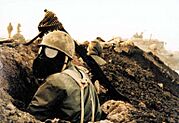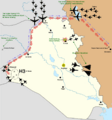Iran–Iraq War facts for kids
Quick facts for kids Iran–Iraq War |
|||||||||
|---|---|---|---|---|---|---|---|---|---|
| Part of the Cold War, aftermath of the Iranian revolution, Iraqi–Kurdish conflict, and Iran–Saudi Arabia proxy conflict | |||||||||
|
Top-left to bottom-right:
|
|||||||||
|
|||||||||
| Belligerents | |||||||||
Salvation Force Arab volunteers |
|||||||||
| Commanders and leaders | |||||||||
| Main Iranian leaders: | Main Iraqi leaders:
|
||||||||
| Units involved | |||||||||
| See order of battle | See order of battle | ||||||||
| Strength | |||||||||
|
Start of war: More:
1,700–2,100 tanks,
KDP: 45,000 Peshmerga (1986–88) PUK: 12,000 Peshmerga (1986–88) |
Start of war: More:
1,750–2,800 tanks,
KDPI: 30,000 Peshmerga (1980–83) MEK: 15,000 fighters (1981–83, 87–88) |
||||||||
| Casualties and losses | |||||||||
|
Military dead: |
Military dead: More:
400,000 WIA
$561 billion |
||||||||
| Civilian dead: 100,000+ Total dead: 450,000–500,000 |
|||||||||
The Iran–Iraq War, also called the First Gulf War, was a big fight between Iran and Iraq. It lasted for almost eight years, from September 1980 to August 1988. The war started when Iraq invaded Iran.
Iraq's leader, Saddam Hussein, wanted to stop Iran's new ideas from spreading. These ideas came from the Iranian revolution in 1979, led by Ruhollah Khomeini. Saddam was also worried that Iran, a country mostly of Shia Muslims, would encourage Iraq's Shia majority to turn against his government. His government was led by Sunni Muslims.
Iraq also wanted to become the most powerful country in the Persian Gulf. Before the Iranian Revolution, Iran was stronger and had close ties with the United States and Israel.
Contents
Why the War Started
The two countries had argued for a long time about their borders. One main reason for the war was a dispute over the Shatt al-Arab waterway. Iraq wanted to take back land it had given to Iran in 1975.
Iraq also supported groups in Iran who wanted to break away. Saddam Hussein might have wanted to take over Iran's Khuzestan province, where many Arabs lived.
How the War Unfolded
Iraq thought it would win quickly because Iran was going through changes after its revolution. But Iraq's army only made progress for about three months. By December 1980, their attack had stopped.
The Iranian army then started to fight back strongly. By June 1982, Iran had taken back all the land it had lost. After pushing Iraqi forces back to the border, Iran decided to invade Iraq.
This part of the war lasted for five years, with Iran fighting inside Iraq. In 1988, Iraq launched its own big attacks. These battles eventually led to the war ending in a tie, with no clear winner.
The End of the War
After eight years, both countries were tired and their economies were badly hurt. Many people had died. The world did not do much when Iraq used chemical weapons against Iranian soldiers and people. Also, tensions grew between Iran and the United States.
All these things led Iran to agree to a ceasefire. This was arranged by the United Nations Security Council.
About 500,000 people died in the war. Iran had more casualties. This number does not include the many thousands of civilians killed in Iraqi Kurdistan during the Anfal campaign.
The war ended with no money paid for damages and no changes to the borders. Both countries lost over $1 trillion in total.
War Tactics and Support
The Iran–Iraq War was like World War I in some ways. Both sides used trench warfare with barbed wire. They had machine guns and sometimes charged with bayonet charges. Iran also used large "human wave" attacks. Iraq used chemical weapons a lot. Both sides also attacked cities and towns where civilians lived.
Many countries supported one side or the other. Iraq received money, political help, and supplies from the United States, the United Kingdom, the Soviet Union, France, Italy, Yugoslavia, and most Arab countries. Iran was more on its own but got help from Syria, Libya, China, North Korea, Israel, Pakistan, and South Yemen.
Related pages
Images for kids
-
Meeting of Mohammad Reza Pahlavi, Houari Boumédiène and Saddam Hussein (left to right) during the Algiers Agreement in 1975.
-
Ruhollah Khomeini rose to power after the Iranian Revolution.
-
Location of Khuzestan Province in Iran which Iraq planned to annex
-
Iranian President Abolhassan Banisadr, who was also commander-in-chief, on a Jeep-mounted 106mm recoilless anti-tank gun. Banisadr was impeached in June 1981.
-
Destroyed Iranian C-47 Skytrain
-
Iranian F-14A Tomcats equipped with AIM-54A, AIM-7 and AIM-9 missiles.
-
Iranian president Abulhassan Banisadr on the battlefront
-
Iraqi T-62 tank wreckage in Khuzestan Province, Iran
-
An admonitory declaration issued from the Iraqi government in order to warn Iranian troops in the Iran–Iraq War. The statement says: "Hey Iranians! No one has been downtrodden in the country where Ali ibn Abi Ṭālib, Husayn ibn Ali and Abbas ibn Ali are buried. Iraq has undoubtedly been an honorable country. All refugees are precious. Anyone who wants to live in exile can choose Iraq freely. We, the Sons of Iraq, have been ambushing foreign aggressors. The enemies who plan to assault Iraq will be disfavoured by God in this world and the hereafter. Be careful of attacking Iraq and Ali ibn Abi Ṭālib! If you surrender, you might be in peace."
-
Operation Earnest Will: Tanker convoy No. 12 under US Navy escort (21 October 1987)
-
Iranian President Ali Khamenei on the battlefront during the Iran–Iraq War
-
Al-Shaheed Monument in Baghdad was erected to commemorate the fallen Iraqi soldiers during the war.
-
Iranian Martyr Cemetery in Isfahan
-
Iranian Martyrs Museum in Tehran
-
An Iranian soldier's funeral in Mashhad, 2013
-
President Ronald Reagan and Vice President George H. W. Bush work in the Oval Office of the White House, 20 July 1984.
-
Damage to a mosque in Khoramshahr, Iran, the city that was invaded by Iraq in September 1980
See also
 In Spanish: Guerra entre Irán e Irak para niños
In Spanish: Guerra entre Irán e Irak para niños










































